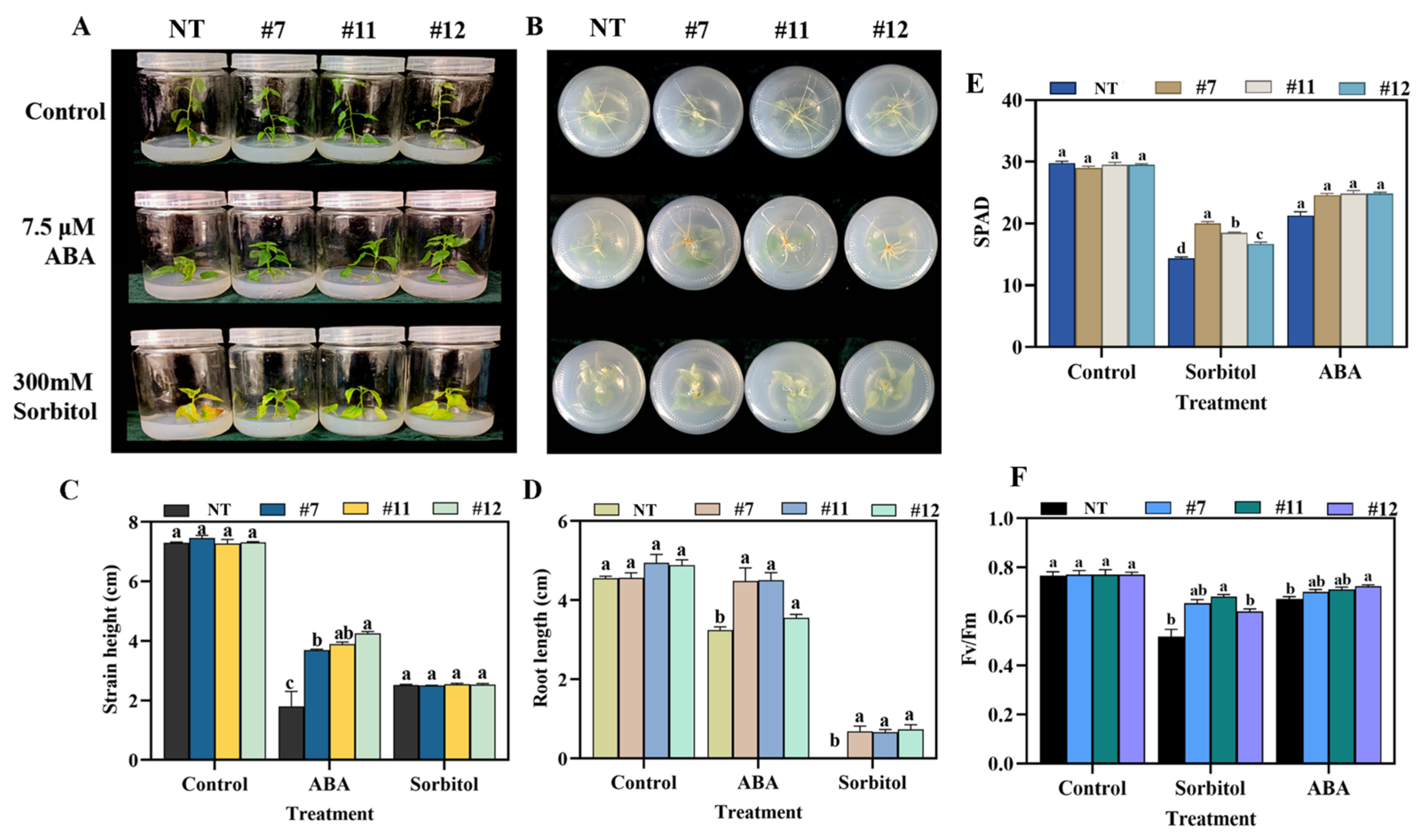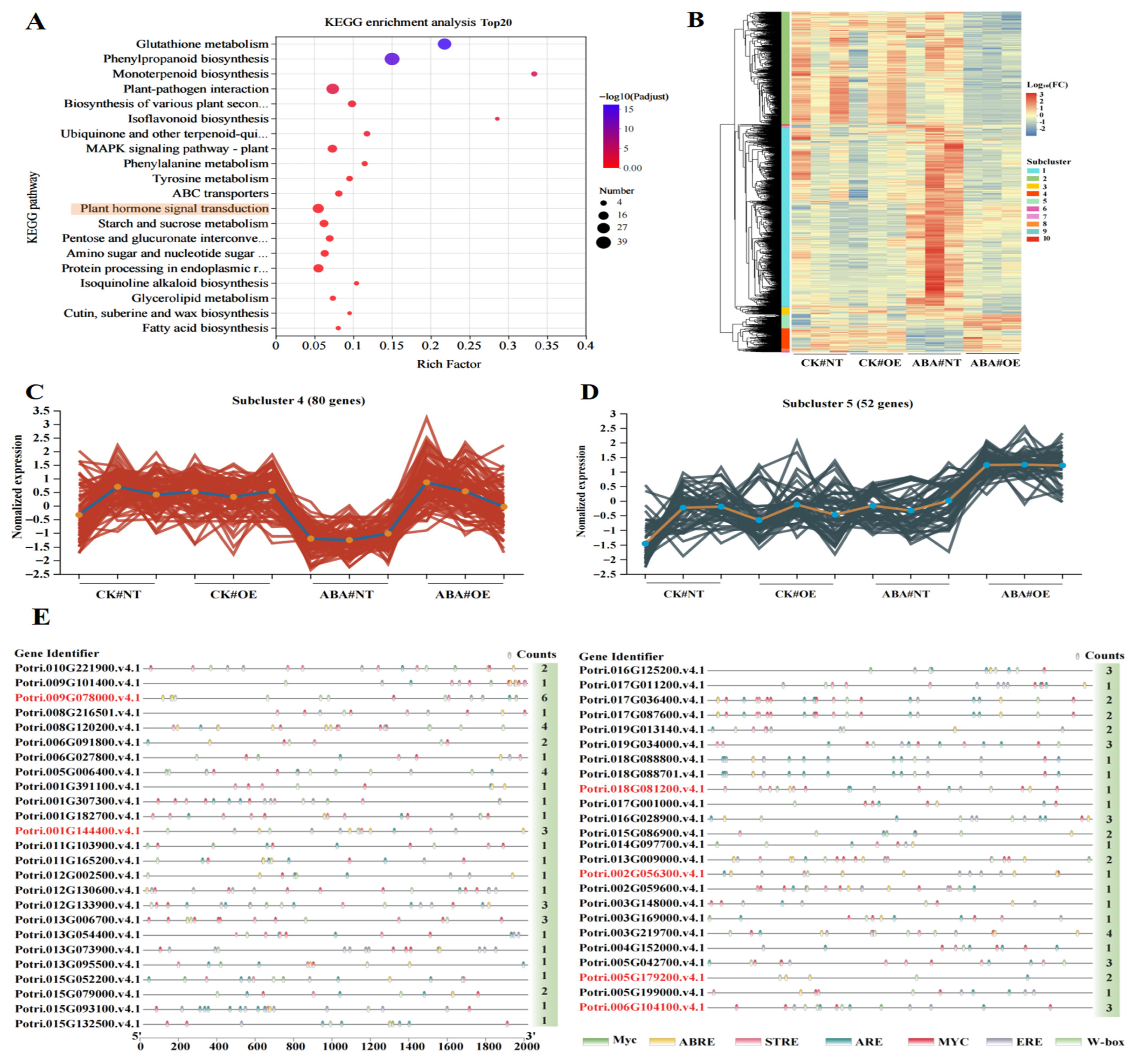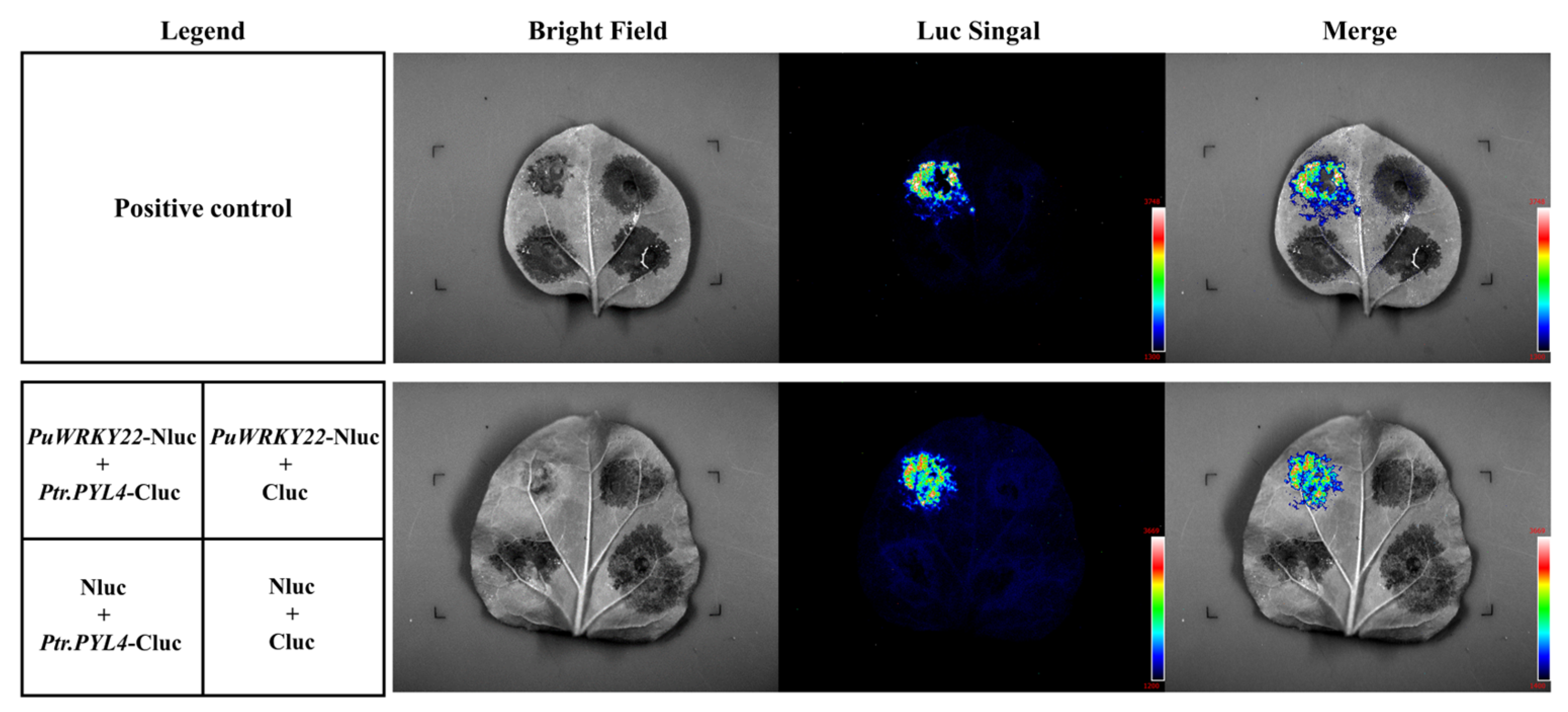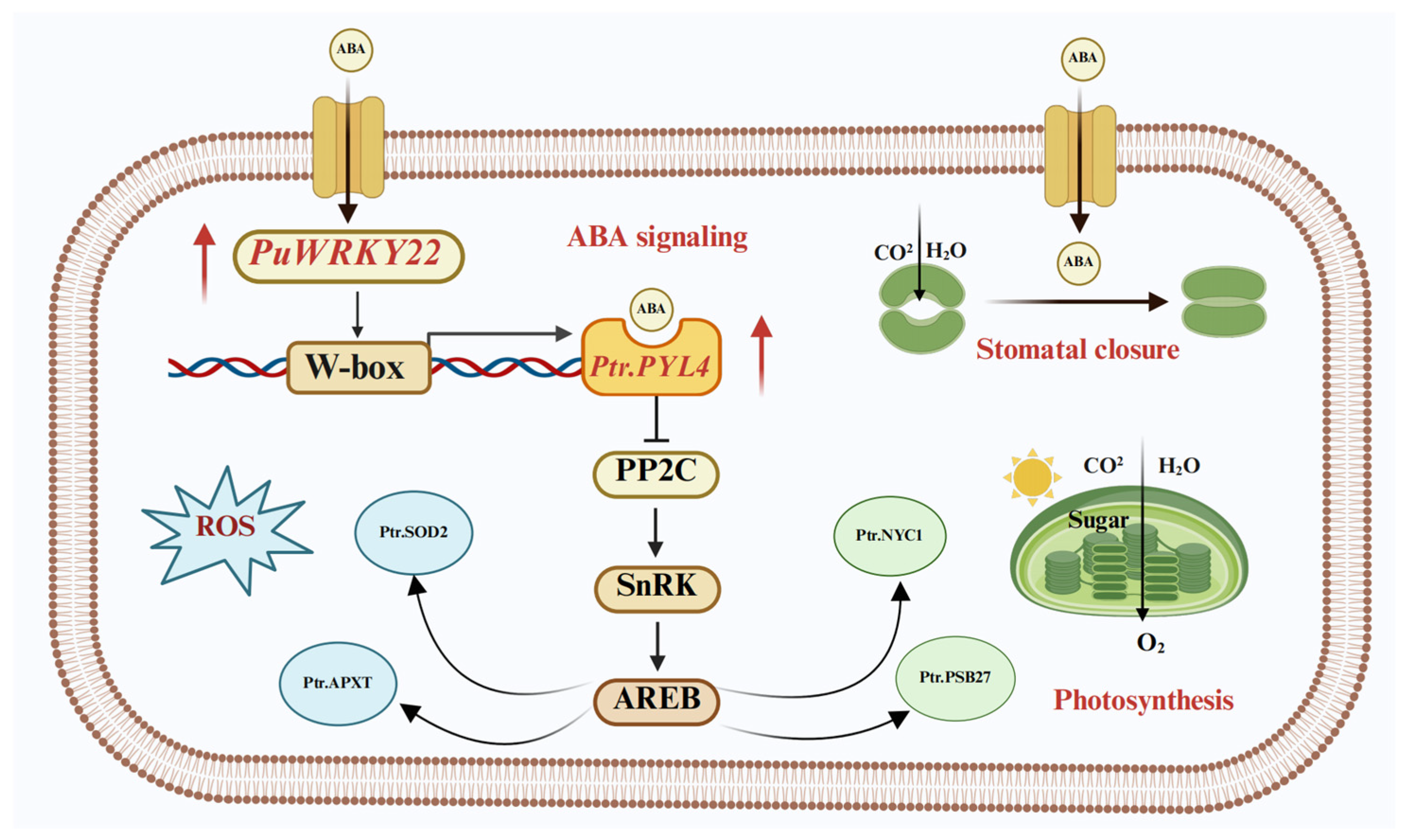Populus ussuriensis PuWRKY22 Transcription Factor Activates the ABA Receptor PYL4 to Enhance Drought Resistance
Abstract
1. Introduction
2. Results
2.1. Homologous Cloning and Functional Analysis of the PuWRKY22 Gene in P. ussuriensis
2.2. Analysis of Drought Tolerance of Overexpressed Tobacco Lines
2.3. Analysis of Drought Tolerance of Overexpressed (OE) P. davidiana × P. bolleana Strains
2.4. Response to Dehydration and Stomatal Changes in Overexpressed and Natural-Type Strains
2.5. Omics Analysis Under ABA Stress
3. Discussion
4. Materials and Methods
4.1. Plant Growth and Treatment
4.2. RNA and DNA Extraction and Gene Cloning
4.3. Analysis of the Expression Specificity of the PuWRKY22 Gene
4.4. Subcellular Localization of PuWRKY22 Protein
4.5. Construction and Activity Validation of the PuWRKY22 Gene Promoter
4.6. Analysis of the Binding Characteristics of PuWRKY22 Protein and W-Box
4.7. Genetic Transformation of PuWRKY22 and Detection of Physiological Indicators After Drought Treatment
4.7.1. Tobacco Genetic Transformation and Identification
4.7.2. Genetic Transformation and Identification of P. davidiana × P. bolleana
4.7.3. Drought Treatment
Genetically Modified Tobacco Strains Simulate Drought Treatment
The Overexpressed P. davidiana × P. bolleana Strain Simulated Drought Treatment
4.7.4. Measurement of Physiological Indicators
Determination of Leaf Electrolyte Permeability
Determination of Chlorophyll Content and Fluorescence Parameters
Determination of Malondialdehyde (MDA) Content
DAB and NBT Staining
4.8. Stomata Structure Analysis
4.9. Bioinformatics Analysis
5. Conclusions
Supplementary Materials
Author Contributions
Funding
Data Availability Statement
Conflicts of Interest
References
- Bonan, G.B. Forests and climate change: Forcings, feedbacks, and the climate benefits of forests. Science 2008, 320, 1444–1449. [Google Scholar] [CrossRef]
- Pennisi, E. Global drought experiment reveals the toll on plant growth. Science 2022, 377, 909–910. [Google Scholar] [CrossRef]
- Choat, B.; Brodribb, T.J.; Brodersen, C.R.; Duursma, R.A.; López, R.; Medlyn, B.E. Triggers of tree mortality under drought. Nature 2018, 558, 531–539. [Google Scholar] [CrossRef]
- Xu, C.Y.; Liu, H.Y.; Ciais, P.; Hartmann, H.; Camarero, J.J.; Wu, X.C.; Hammond, W.M.; Allen, C.D.; Chen, F.H. Enhanced Drought Exposure Increasingly Threatens More Forests Than Observed. Earths Future 2024, 12, 13. [Google Scholar] [CrossRef]
- Jiang, Z.; Zhu, H.; Zhu, H.; Tao, Y.; Liu, C.; Liu, J.; Yang, F.; Li, M. Exogenous ABA Enhances the Antioxidant Defense System of Maize by Regulating the AsA-GSH Cycle under Drought Stress. Sustainability 2022, 14, 3071. [Google Scholar] [CrossRef]
- Hsu, P.K.; Dubeaux, G.; Takahashi, Y.; Schroeder, J.I. Signaling mechanisms in abscisic acid-mediated stomatal closure. Plant J. 2021, 105, 307–321. [Google Scholar] [CrossRef] [PubMed]
- Liu, H.; Song, S.; Zhang, H.; Li, Y.; Niu, L.; Zhang, J.; Wang, W. Signaling Transduction of ABA, ROS, and Ca2+ in Plant Stomatal Closure in Response to Drought. Int. J. Mol. Sci. 2022, 23, 4824. [Google Scholar] [CrossRef]
- Li, Y.; Ding, Y.; Qu, L.; Li, X.; Lai, Q.; Zhao, P.; Gao, Y.; Xiang, C.; Cang, C.; Liu, X.; et al. Structure of the Arabidopsis guard cell anion channel SLAC1 suggests activation mechanism by phosphorylation. Nat. Commun. 2022, 13, 2511. [Google Scholar] [CrossRef]
- Hasan, M.M.; Liu, X.D.; Waseem, M.; Guang-Qian, Y.; Alabdallah, N.M.; Jahan, M.S.; Fang, X.W. ABA activated SnRK2 kinases: An emerging role in plant growth and physiology. Plant Signal. Behav. 2022, 17, 2071024. [Google Scholar] [CrossRef]
- Kwak, J.M.; Mori, I.C.; Pei, Z.M.; Leonhardt, N.; Torres, M.A.; Dangl, J.L.; Bloom, R.E.; Bodde, S.; Jones, J.D.; Schroeder, J.I. NADPH oxidase AtrbohD and AtrbohF genes function in ROS-dependent ABA signaling in Arabidopsis. EMBO J. 2003, 22, 2623–2633. [Google Scholar] [CrossRef] [PubMed]
- Jiang, M.Y.; Zhang, J.H. Abscisic acid and antioxidant defense in plant cells. Acta Bot. Sin. 2004, 46, 1–9. [Google Scholar]
- Hasanuzzaman, M.; Bhuyan, M.; Anee, T.I.; Parvin, K.; Nahar, K.; Mahmud, J.A.; Fujita, M. Regulation of Ascorbate-Glutathione Pathway in Mitigating Oxidative Damage in Plants under Abiotic Stress. Antioxidants 2019, 8, 384. [Google Scholar] [CrossRef]
- Rajab, H.; Khan, M.S.; Malagoli, M.; Hell, R.; Wirtz, M. Sulfate-Induced Stomata Closure Requires the Canonical ABA Signal Transduction Machinery. Plants 2019, 8, 21. [Google Scholar] [CrossRef]
- Maeng, C.H.; Fujita, T.; Kishimoto, J.; Tanaka, R.; Takabayashi, A.; Fujita, T. Abscisic acid enhances non-photochemical quenching through SnRK2 and ABI3 in Physcomitrium patens. J. Plant Res. 2025, 138, 625–636. [Google Scholar] [CrossRef]
- Li, Z.Q.; Zou, D.F.; Nie, C.J.; Chen, X.; He, C.; Zheng, X.B.; Tan, B.; Cheng, J.; Wang, W.; Martínez-Gómez, P.; et al. VvABF5 promotes ABA-mediated chlorophyll degradation by transcriptional activation of VvSGR during rachis browning of grape. Postharvest Biol. Technol. 2025, 222, 9. [Google Scholar] [CrossRef]
- Theis, J.; Schroda, M. Revisiting the photosystem II repair cycle. Plant Signal. Behav. 2016, 11, e1218587. [Google Scholar] [CrossRef] [PubMed]
- Teng, K.; Tan, P.H.; Guan, J.; Dong, D.; Liu, L.Y.; Guo, Y.D.; Guo, W.E.; Yuesen, Y.; Fan, X.F.; Wu, J.Y. Functional characterization of the chlorophyll b reductase gene NYC1 associated with chlorophyll degradation and photosynthesis in Zoysia japonica. Environ. Exp. Bot. 2021, 191, 11. [Google Scholar] [CrossRef]
- Wang, H.; Cheng, X.; Yin, D.; Chen, D.; Luo, C.; Liu, H.; Huang, C. Advances in the Research on Plant WRKY Transcription Factors Responsive to External Stresses. Curr. Issues Mol. Biol. 2023, 45, 2861–2880. [Google Scholar] [CrossRef]
- Jiang, J.; Ma, S.; Ye, N.; Jiang, M.; Cao, J.; Zhang, J. WRKY transcription factors in plant responses to stresses. J. Integr. Plant Biol. 2017, 59, 86–101. [Google Scholar] [CrossRef] [PubMed]
- Wei, W.; Liang, D.W.; Bian, X.H.; Shen, M.; Xiao, J.H.; Zhang, W.K.; Ma, B.; Lin, Q.; Lv, J.; Chen, X.; et al. GmWRKY54 improves drought tolerance through activating genes in abscisic acid and Ca2+ signaling pathways in transgenic soybean. Plant J. 2019, 100, 384–398. [Google Scholar] [CrossRef]
- Hussain, Q.; Asim, M.; Zhang, R.; Khan, R.; Farooq, S.; Wu, J. Transcription Factors Interact with ABA through Gene Expression and Signaling Pathways to Mitigate Drought and Salinity Stress. Biomolecules 2021, 11, 1159. [Google Scholar] [CrossRef]
- Chen, K.; Li, G.J.; Bressan, R.A.; Song, C.P.; Zhu, J.K.; Zhao, Y. Abscisic acid dynamics, signaling, and functions in plants. J. Integr. Plant Biol. 2020, 62, 25–54. [Google Scholar] [CrossRef]
- González-Hernández, A.I.; Scalschi, L.; García-Agustín, P.; Camañes, G. Tomato root development and N assimilation depend on C and ABA content under different N sources. Plant Physiol. Biochem. 2020, 148, 368–378. [Google Scholar] [CrossRef]
- Yu, S.; He, Z.; Gao, K.; Zhou, J.; Lan, X.; Zhong, C.; Xie, J. Dioscorea composita WRKY12 is involved in the regulation of salt tolerance by directly activating the promoter of AtRCI2A. Plant Physiol. Biochem. 2023, 196, 746–758. [Google Scholar] [CrossRef] [PubMed]
- Sun, S.; Li, X.; Gao, S.; Nie, N.; Zhang, H.; Yang, Y.; He, S.; Liu, Q.; Zhai, H. A Novel WRKY Transcription Factor from Ipomoea trifida, ItfWRKY70, Confers Drought Tolerance in Sweet Potato. Int. J. Mol. Sci. 2022, 23, 686. [Google Scholar] [CrossRef]
- Nakashima, K.; Yamaguchi-Shinozaki, K. ABA signaling in stress-response and seed development. Plant Cell Rep. 2013, 32, 959–970. [Google Scholar] [CrossRef]
- Luo, X.; Bai, X.; Sun, X.; Zhu, D.; Liu, B.; Ji, W.; Cai, H.; Cao, L.; Wu, J.; Hu, M.; et al. Expression of wild soybean WRKY20 in Arabidopsis enhances drought tolerance and regulates ABA signalling. J. Exp. Bot. 2013, 64, 2155–2169. [Google Scholar] [CrossRef]
- Mehmandar, M.N.; Rasouli, F.; Giglou, M.T.; Zahedi, S.M.; Hassanpouraghdam, M.B.; Aazami, M.A.; Tajaragh, R.P.; Ryant, P.; Mlcek, J. Polyethylene Glycol and Sorbitol-Mediated In Vitro Screening for Drought Stress as an Efficient and Rapid Tool to Reach the Tolerant Cucumis melo L. Genotypes. Plants 2023, 12, 870. [Google Scholar] [CrossRef]
- Baillo, E.; Hanif, M.S.; Xu, P.; Zhang, Z.B. Sorghum WRKY transcription factor SbWRKY45 enhanced seed germination under drought stress in transgenic Arabidopsis. Turk. J. Bot. 2023, 47, 23–33. [Google Scholar] [CrossRef]
- Yang, Z.; Chi, X.; Guo, F.; Jin, X.; Luo, H.; Hawar, A.; Chen, Y.; Feng, K.; Wang, B.; Qi, J.; et al. SbWRKY30 enhances the drought tolerance of plants and regulates a drought stress-responsive gene, SbRD19, in sorghum. J. Plant Physiol. 2020, 246–247, 153142. [Google Scholar] [CrossRef] [PubMed]
- Zhou, X.; Yang, S.; Zhou, F.; Xu, L.; Shi, C.; He, Q. Physiological, Cytological and Transcriptome Analysis of a Yellow-Green Leaf Mutant in Magnolia sinostellata. Plants 2025, 14, 1037. [Google Scholar] [CrossRef]
- Corrêa, C.C.G.; Barroso, T.S.; Xavier, L.R.; Pinto, V.B.; Reis, R.S.; Pena, G.F.; Santa-Catarina, C.; Vivas, M.; do Amaral Júnior, A.T.; Silveira, V. Comparative Proteomic Analysis of Popcorn Genotypes Identifies Differentially Accumulated Proteins Associated with Resistance Pathways to Southern Leaf Blight Disease. Plants 2025, 14, 426. [Google Scholar] [CrossRef]
- Nakato, R.; Sakata, T. Methods for ChIP-seq analysis: A practical workflow and advanced applications. Methods 2021, 187, 44–53. [Google Scholar] [CrossRef] [PubMed]
- Hellman, L.M.; Fried, M.G. Electrophoretic mobility shift assay (EMSA) for detecting protein-nucleic acid interactions. Nat. Protoc. 2007, 2, 1849–1861. [Google Scholar] [CrossRef] [PubMed]
- Rio, D.C.; Ares, M., Jr.; Hannon, G.J.; Nilsen, T.W. Purification of RNA using TRIzol (TRI reagent). Cold Spring Harb. Protoc. 2010, 2010, pdb.prot5439. [Google Scholar] [CrossRef]
- Kuo, P.; Henderson, I.R.; Lambing, C. CTAB DNA Extraction and Genotyping-by-Sequencing to Map Meiotic Crossovers in Plants. Methods Mol. Biol. 2022, 2484, 43–53. [Google Scholar] [CrossRef]
- Bachman, J. Reverse-transcription PCR (RT-PCR). Methods Enzymol. 2013, 530, 67–74. [Google Scholar] [CrossRef]
- Li, Y.; Chen, T.; Wang, W.; Liu, H.; Yan, X.; Wu-Zhang, K.; Qin, W.; Xie, L.; Zhang, Y.; Peng, B.; et al. A high-efficiency Agrobacterium-mediated transient expression system in the leaves of Artemisia annua L. Plant Methods 2021, 17, 106. [Google Scholar] [CrossRef]
- Béziat, C.; Kleine-Vehn, J.; Feraru, E. Histochemical Staining of β-Glucuronidase and Its Spatial Quantification. Methods Mol. Biol. 2017, 1497, 73–80. [Google Scholar] [CrossRef]
- Weigel, D.; Glazebrook, J. Transformation of agrobacterium using electroporation. CSH Protoc. 2006, 2006, pdb.prot4665. [Google Scholar] [CrossRef] [PubMed]
- Daudi, A.; O’Brien, J.A. Detection of Hydrogen Peroxide by DAB Staining in Arabidopsis Leaves. Bio Protoc. 2012, 2, e263. [Google Scholar] [CrossRef]
- Jambunathan, N. Determination and detection of reactive oxygen species (ROS), lipid peroxidation, and electrolyte leakage in plants. Methods Mol. Biol. 2010, 639, 292–298. [Google Scholar] [CrossRef] [PubMed]








Disclaimer/Publisher’s Note: The statements, opinions and data contained in all publications are solely those of the individual author(s) and contributor(s) and not of MDPI and/or the editor(s). MDPI and/or the editor(s) disclaim responsibility for any injury to people or property resulting from any ideas, methods, instructions or products referred to in the content. |
© 2025 by the authors. Licensee MDPI, Basel, Switzerland. This article is an open access article distributed under the terms and conditions of the Creative Commons Attribution (CC BY) license (https://creativecommons.org/licenses/by/4.0/).
Share and Cite
Wang, Q.; Li, D.; Yang, L.; Yang, Y.; Huang, S.; Zhao, Y.; Guan, Q. Populus ussuriensis PuWRKY22 Transcription Factor Activates the ABA Receptor PYL4 to Enhance Drought Resistance. Plants 2025, 14, 2621. https://doi.org/10.3390/plants14172621
Wang Q, Li D, Yang L, Yang Y, Huang S, Zhao Y, Guan Q. Populus ussuriensis PuWRKY22 Transcription Factor Activates the ABA Receptor PYL4 to Enhance Drought Resistance. Plants. 2025; 14(17):2621. https://doi.org/10.3390/plants14172621
Chicago/Turabian StyleWang, Qiuhui, Danni Li, Lihua Yang, Yu Yang, Shuchao Huang, Yipeng Zhao, and Qingjie Guan. 2025. "Populus ussuriensis PuWRKY22 Transcription Factor Activates the ABA Receptor PYL4 to Enhance Drought Resistance" Plants 14, no. 17: 2621. https://doi.org/10.3390/plants14172621
APA StyleWang, Q., Li, D., Yang, L., Yang, Y., Huang, S., Zhao, Y., & Guan, Q. (2025). Populus ussuriensis PuWRKY22 Transcription Factor Activates the ABA Receptor PYL4 to Enhance Drought Resistance. Plants, 14(17), 2621. https://doi.org/10.3390/plants14172621







